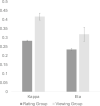Rating expectations can slow aversive reversal learning
- PMID: 34837385
- PMCID: PMC8810599
- DOI: 10.1111/psyp.13979
Rating expectations can slow aversive reversal learning
Abstract
The process of learning allows organisms to develop predictions about outcomes in the environment, and learning is sensitive to both simple associations and higher order knowledge. However, it is unknown whether consciously attending to expectations shapes the learning process itself. Here, we directly tested whether rating expectations shapes arousal during classical conditioning. Participants performed an aversive learning paradigm wherein one image (CS+) was paired with shock on 50% of trials, while a second image (CS-) was never paired with shock. Halfway through the task, contingencies reversed. One group of participants rated the probability of upcoming shock on each trial, while the other group made no online ratings. We measured skin conductance response (SCR) evoked in response to the CS and used traditional analyses as well as quantitative models of reinforcement learning to test whether rating expectations influenced arousal and aversive reversal learning. Participants who provided online expectancy ratings displayed slower learning based on a hybrid model of adaptive learning and reduced reversal of SCR relative to those who did not rate expectations. Mediation analysis revealed that the effect of associative learning on SCR could be fully explained through its effects on subjective expectancy within the group who provided ratings. This suggests that the act of rating expectations reduces the speed of learning, likely through changes in attention, and that expectations directly influence arousal. Our findings indicate that higher order expectancy judgments can alter associative learning.
Keywords: aversive learning; conditioning; defensive; expectancy; fear; reinforcement learning; skin conductance; threat.
© 2021 The Authors. Psychophysiology published by Wiley Periodicals LLC on behalf of Society for Psychophysiological Research. This article has been contributed to by US Government employees and their work is in the public domain in the USA.
Figures





Similar articles
-
Attention avoidance of the threat conditioned stimulus during extinction increases physiological arousal generalisation and retention.Behav Res Ther. 2018 May;104:51-61. doi: 10.1016/j.brat.2018.03.001. Epub 2018 Mar 6. Behav Res Ther. 2018. PMID: 29549751 Clinical Trial.
-
Eye Movements Index Implicit Memory Expression in Fear Conditioning.PLoS One. 2015 Nov 12;10(11):e0141949. doi: 10.1371/journal.pone.0141949. eCollection 2015. PLoS One. 2015. PMID: 26562298 Free PMC article.
-
Potentiation of the startle reflex is in line with contingency reversal instructions rather than the conditioning history.Biol Psychol. 2016 Jan;113:91-9. doi: 10.1016/j.biopsycho.2015.11.014. Epub 2015 Nov 30. Biol Psychol. 2016. PMID: 26655786
-
Event-related potential components as measures of aversive conditioning in humans.Psychophysiology. 2018 Apr;55(4):10.1111/psyp.13015. doi: 10.1111/psyp.13015. Epub 2017 Sep 26. Psychophysiology. 2018. PMID: 28949030 Free PMC article.
-
Beyond arousal: Prediction error related to aversive events promotes episodic memory formation.J Exp Psychol Learn Mem Cogn. 2020 Feb;46(2):234-246. doi: 10.1037/xlm0000728. Epub 2019 Jun 6. J Exp Psychol Learn Mem Cogn. 2020. PMID: 31169402
Cited by
-
Enhancing precision in human neuroscience.Elife. 2023 Aug 9;12:e85980. doi: 10.7554/eLife.85980. Elife. 2023. PMID: 37555830 Free PMC article. Review.
-
Event Segmentation Promotes the Reorganization of Emotional Memory.J Cogn Neurosci. 2025 Jan 2;37(1):110-134. doi: 10.1162/jocn_a_02244. J Cogn Neurosci. 2025. PMID: 39231276 Free PMC article.
-
Expectation generation and its effect on subsequent pain and visual perception.PLoS Comput Biol. 2025 May 22;21(5):e1013053. doi: 10.1371/journal.pcbi.1013053. eCollection 2025 May. PLoS Comput Biol. 2025. PMID: 40402974 Free PMC article.
-
Confidence of probabilistic predictions modulates the cortical response to pain.Proc Natl Acad Sci U S A. 2023 Jan 24;120(4):e2212252120. doi: 10.1073/pnas.2212252120. Epub 2023 Jan 20. Proc Natl Acad Sci U S A. 2023. PMID: 36669115 Free PMC article.
-
How Instructions, Learning, and Expectations Shape Pain and Neurobiological Responses.Annu Rev Neurosci. 2023 Jul 10;46:167-189. doi: 10.1146/annurev-neuro-101822-122427. Epub 2023 Mar 14. Annu Rev Neurosci. 2023. PMID: 36917820 Free PMC article. Review.
References
-
- Akaike, H. (1974). A new look at the statistical model identification. IEEE Transactions on Automatic Control, 19(6), 716–723. 10.1109/TAC.1974.1100705 - DOI
-
- Atlas, L. Y. (2019). How instructions shape aversive learning: Higher order knowledge, reversal learning, and the role of the amygdala. Current Opinion in Behavioral Sciences, 26, 121–129. 10.1016/j.cobeha.2018.12.008 - DOI
Publication types
MeSH terms
Grants and funding
LinkOut - more resources
Full Text Sources

